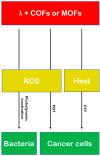Recent Trends in Covalent and Metal Organic Frameworks for Biomedical Applications
- PMID: 30405018
- PMCID: PMC6265694
- DOI: 10.3390/nano8110916
Recent Trends in Covalent and Metal Organic Frameworks for Biomedical Applications
Abstract
Materials science has seen a great deal of advancement and development. The discovery of new types of materials sparked the study of their properties followed by applications ranging from separation, catalysis, optoelectronics, sensing, drug delivery and biomedicine, and many other uses in different fields of science. Metal organic frameworks (MOFs) and covalent organic frameworks (COFs) are a relatively new type of materials with high surface areas and permanent porosity that show great promise for such applications. The current study aims at presenting the recent work achieved in COFs and MOFs for biomedical applications, and to examine some challenges and future directions which the field may take. The paper herein surveys their synthesis, and their use as Drug Delivery Systems (DDS), in non-drug delivery therapeutics and for biosensing and diagnostics.
Keywords: biomedicine; covalent organic frameworks (COFs); drug delivery systems; metal organic frameworks (MOFs); nanomaterials.
Conflict of interest statement
The authors declare no conflict of interest.
Figures



References
-
- Getting Chemistry into Shape. [(accessed on 30 July 2018)]; Available online: https://www.nobelprize.org/nobel_prizes/chemistry/laureates/1987/speedre....
Publication types
LinkOut - more resources
Full Text Sources
Other Literature Sources

